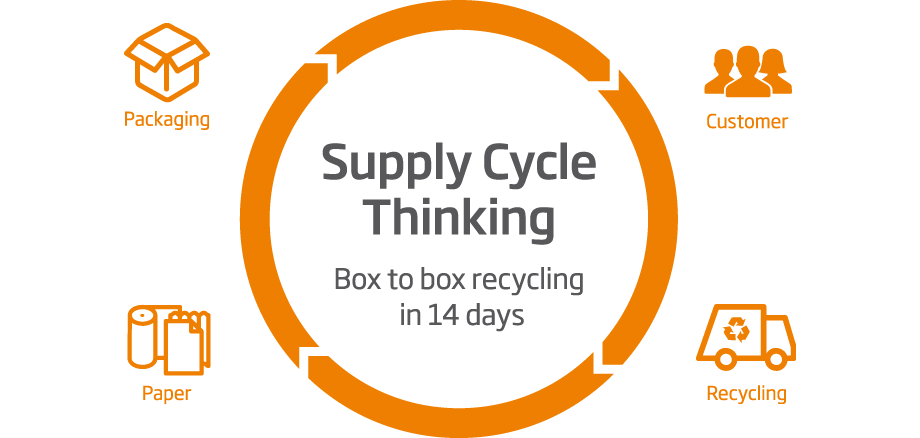Quality calls for consistency in collections

DS Smith is Europe’s largest paper and cardboard recycler. We’re an integrated packaging group, with our own paper mills, packaging plants and recycling operations. We operate in 36 countries, collecting over 5 million tonnes of paper and cardboard for recycling every year. We have a vested interested in the material we collect – it provides the raw material for our papermaking and packaging production processes.
We make boxes for our customers, collect them at the end of their life, turn them into other boxes, and ship boxes out again within 14 days. Packaging, paper and cardboard pass through our closed loop, from our ten paper mills to our 177 packaging plants.
In 2015, the DS Smith Group produced over 6 billion boxes, and 78% of the fibre that we used came from recycled sources.

The question of quality
Packaging has its place in a circular economy – if it’s sourced, designed and produced sustainably.
You may recall the Kenco Coffee adverts with the farmer holding coffee beans that stream through his fingers: ‘we tried 100% less packaging’ quipped the voice-over. In order to move products, packaging is a necessity – but the right packaging will protect its product and reduce wastage from transit damage without becoming waste itself.
Paper-based packaging can readily be recycled. In 2014, paper and cardboard comprised 41% of all materials collected for recycling in the UK, and since 2006 the UK has recycled an average of 60% of our packaging every year. But to increase those recycling rates and keep waste to a minimum, we must always focus on quality.
Our boxes need to perform excellently, whether they’re designed to protect products in transit, or are intended to be retail-ready, advertising to consumers on the shop floor. Our boxes need to be reliable – and that’s why we can’t have any contamination getting into our recycling and production processes.
To make good quality sustainable packaging, we need good quality raw material – and that starts with quality recycling collections.
Collections and contamination
Collecting material that has been ‘source segregated’ – where recyclable materials have been gathered and stored separately prior to collection – delivers the best raw materials for fibre reprocessors. Commingled collection systems, though they can be practical and accessible, result in a higher rate of contamination of potentially recyclable materials.

Maintaining the quality of our fibre is central to our recycled paper sourcing strategy. Too much contamination can cause our production processes to grind to a halt – resulting in thousands of pounds of lost production time, and even broken machinery.
Material that is heavily contaminated may need to be rejected even before it reaches a paper mill. We can’t make quality products out of contaminated fibre, so it can end up in landfill or waste to energy, resulting in more cost and environmental impact.
Contamination can come from other recyclables as well as non-recyclables. Food contamination is a real issue for paper mills, and we continue to campaign hard to make sure that food waste is always collected separately.
Our focus on quality is why DS Smith supports the development of recognised standards for paper grades, and has worked with the Confederation of European Paper Industries (CEPI) to formalise the EN643 recovered paper standard as the recognised minimum benchmark for the production of paper for recovery. CEPI has also produced guidelines for the manufacture of Paper for Recycling (PfR), which we believe can assist recyclers and regulators in ensuring PfR has been produced properly.
This benchmark needs to be reached wherever we are sourcing PfR. As a leading producer of consumer packaging, we source a lot of material from retailers and FMCG companies. However, due to changing social and consumer habits, more and more packaging is finding its way into domestic waste streams, which means we need to account for different sources of PfR.
The impact of the internet
Retailers and businesses that generate large volumes of waste need control over how they manage their material. That makes it easier to keep paper and card clean, away from food waste and other contaminants. But for local authorities, who collect from the UK’s 27 million households, separating waste streams is a much greater challenge – especially as those waste streams change in line with consumer behaviour.
The rise of the internet and social media means that the public are reading and recycling fewer newspapers, where online shopping means that they’re recycling more brown cardboard boxes.
That increase in cardboard means that the ‘mixed papers’ collected by Local Authorities is ideal for DS Smith to make it into new packaging. If this feedstock can be kept free from contamination, we can collect and recycle these papers back into the 6 billion boxes we produce every year.
Across England, different households experience a wide range of systems for collecting their material. WRAP’s Framework for Greater Consistency in Household Recycling in England recommends three potential structures for national, standardised collections – following on from Wales and Scotland’s models to illustrate successful examples of separate collections. Their detailed supporting evidence concludes that source-separated materials produce the best overall outcome for local authorities:
If all local authorities were to adopt this approach… there is a potential financial benefit of up to £658 million. Multi-stream collections provide the greatest opportunity to increase income from the sale of secondary materials with up to £433 million in additional revenues from recyclate sales possible over the 8 year period to 2025/26.
The quality of consistency
Our boxes contain a global average of 78% recycled fibre. In some areas of our operations, we’re able to use as much as 98% recycled material to make boxes. The variation depends on many factors, but the most important of them is quality.
The key to using recycled content is ensuring that it is clean of contamination. DS Smith believes this is best done by collecting paper separately, and has championed separate collections since the implementation of the Waste Framework Directive.
That’s why we welcome WRAP’s Greater Consistency Framework and its focus on the increased recyclability of clean, high-quality paper. We are interested to see how the greater consistency will be implemented across England. The economic and environmental case for greater consistency is compelling.
Whatever the outcome, DS Smith will continue to raise concerns about the costs of dealing with low-quality recycling. Greater consistency is indeed needed, but it needs to be the right consistency – a consistency that maximises quality and reduces waste at every opportunity.